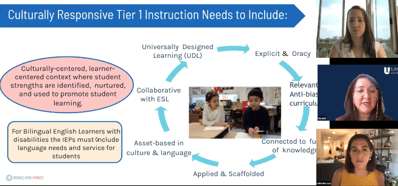
Supporting English Language Learners, Bilingual, and Dual-Language Students in MTSS
A strong and effective MTSS model should support all students, no matter their language preference and background. Despite the number of students in the United States who come from diverse linguistic backgrounds, the programs and supports provided often do not meet the needs of non-English speakers. In addition, students who do not speak English as their first language are often identified as having underlying reading issues, when the problem lies in the proper translational skills from one language to another.
For students in Bilingual or Dual-Language programs, the support being provided should also address the learning needs in both languages. The following are examples of programs and practices that can specifically be used within Bilingual and Dual-Language classrooms as well as with students who are English Language Learners (ELLs) to better support their development of reading across languages.
Estrellita
Estrellita is an early Spanish literacy program for Bilingual and Dual Language classrooms. The program aims to help English Language Learners make a smooth transition to English. The program is based on the core structure of the Spanish language and is not simply a translation from English to Spanish. Estrellita has pre-k and K-1 programs. Both programs teach phonemic awareness through age-appropriate activities, stories, games, and cheers. The programs also include multi-sensory components. Estrellita also provides in-person and online professional development for educators.
Many of the approaches and methods used in the Estrellita program are grounded in research. For example, research on early reading in Spanish has demonstrated that vowels should be taught before consonants. In addition, phonemic and phonological awareness are not precursors to reading in Spanish, but are integral to the reading process and should be taught concurrently with reading and writing, which is different from phonemic awareness in English.
Imagine Español
Imagine Español is a personalized learning solution that accelerates grade-level reading and language proficiency in Spanish for students in grades PreK–2. Designed to address the diverse instructional needs of native speakers, Imagine Español teaches foundational literacy skills in an engaging, game-like environment that celebrates the cultures of the Spanish-speaking world.
Imagine Español is designed to fit flexibly into bilingual and dual-language programs to extend and enrich instruction. Students learning remotely can work independently in their personalized learning pathways. Teachers can also use offline resources, including printable decodable books, vocabulary flashcards, and review activities, to help teachers individualize instruction for every student. Preliminary research showed that first graders using Imagine Español in a dual-language program in Texas outperformed non-users on the STAR Reading Spanish Test.
Esperenza
Esperanza is a Spanish multisensory structured language program for reading, writing, and spelling. The program provides a multisensory, sequential, systematic approach to achieving Spanish literacy. Esperanza incorporates essential components of an effective literacy program as defined by the National Literacy Panel. The program can also be used as an early reading intervention program for Spanish-speaking students.
The program includes three levels:
- Lenguaje y Lectura (pre-k and k) focuses on early literacy skills, such as phonological awareness, the alphabetic principle, phonics, early writing skills, oral language, and comprehension.
- First and second-grade Esperanza lessons systematically and cumulatively develop a strong knowledge of the structure of the Spanish language so that the student can read, write, and spell in their primary language.
- The WELLS (Working with English Language Learners) transition program allows students to apply their knowledge of phonology, phonics, vocabulary, and the rules of one language for the acquisition of the second language.
Program material can be purchased directly through the program website.
El Camino Al Éxito
El Camino Al Éxito is a Tier 2 Spanish phonics curriculum for early readers in Spanish Literacy or Two-Way Dual Language Immersion programs. The materials focus on teaching letter sounds and syllable segmenting and blending through explicit lessons, games, and activities. It includes a 30-minute daily lesson, which is delivered in groups of 2-5 students. Preliminary research has shown that the program can reduce the number of students at-risk for language and reading problems. The program is also aligned with Common Core Standards for Spanish Language Arts (Reading Foundational Skills) and Texas Essential Knowledge and Skills (TEKS).
Read Conmigo
Read Conmigo is a bilingual family reading program. It includes free children's books along with activities, games, and resources to promote early bilingual reading skills. The program provides parents and educators with access to an online library of culturally diverse children’s stories in both English and Spanish. Each eBook includes an activity to guide reading comprehension and vocabulary acquisition. Games and activities to support bilingual reading skills are also provided.
Parents and teachers can sign up for free through the Read Conmigo website. To access the online book library and educational apps, click Books on the top menu. All eBooks are compatible with most Apple iOS, Amazon Kindle, and Android devices as well as laptop and desktop computers.
Soluciones
Soluciones is a comprehensive K–2 Spanish Reading program that provides intensive language development and support for early bilingual readers. The program is based on authentic leveled Spanish texts and readers. It also includes instructional lessons, pictures with letter cards, and assessments.
The program offers 60-86 titles of leveled texts per grade plus additional materials for instruction, such as picture and letter cards, oral reading record kits, and assessments. Lessons are structured around specific texts and readers, which are accompanied by lessons, posters, and activities.
Vocabulary Improvement Program for ELLs
This vocabulary development curriculum for ELLs and native English speakers, in grades 4–6, aims to increase students' understanding of target vocabulary words. The 15-week program includes 30–45 minute whole class and small group activities, which aim to increase students' understanding of target vocabulary words included in a weekly reading assignment.
Research studies have shown that students' vocabulary knowledge strongly correlates with their success in reading comprehension. This program uses innovative approaches to help students build a "toolbox" of skills that let them decipher the meanings of unfamiliar words with confidence. The curriculum itself has also been shown to have significant effects on students’ reading achievement and English language development.
Pearson Language Centre
Pearson Language Central is an English language development program that aligns with other core Pearson programs. The program allows ELLs in grades 6-12 to participate in core lessons. The program provides systematic, flexible, and comprehensive lessons to help English Language Learners produce oral and written language and learn critical vocabulary and reading comprehension skills. It consists of daily 30 minute lessons which can be used alongside any core literacy program.
Partner Reading for ELL
This partner reading strategy can be used to help ELL students build reading comprehension skills. Teachers can use this activity to pair an ELL student with a non-ELL student to support language development.
The approach allows students to take turns reading and provide each other with feedback as a way to monitor comprehension. The method is also evidence-based; in classrooms that implemented the strategy, ELL students with learning disabilities showed significant improvements in reading fluency and reading comprehension.
When using this strategy, teachers should first choose the assigned reading and introduce the text to students. Create pairs within the classroom by identifying which children require help on specific skills and who the most appropriate children are to help other children learn those skills. Next, model the procedure to ensure that students understand how to use the strategy. Have each member of the teacher-assigned pair take turns being "Coach" and "Player." These pairs are changed regularly, and over a period of time as students work. It is also important for teachers to monitor and support students as they work together. Have the stronger reader begin this activity as the "Player" and read orally for 5 minutes. Have the "Coach" follow along and correct any mistakes when necessary. The pairs should switch roles and ask the weaker reader to become the "Player." The "Player" rereads the same passage for the next 5 minutes and the "Coach" provides corrective feedback.
On-Demand Webinar:
👉 Supporting English Learners Within MTSS 👈
Learn more about ELLs from this webinar with Professor Claudia Rinaldi, author of Practical Ways to Engage All Struggling Readers: A Multi-Tiered Approach Using Hi-Lo Books to learn about how to support English learners within a Multi-Tiered System of Supports (MTSS) framework.
The most comprehensive and instructive library of evidence-based learning supports of any MTSS platformBranching Minds has the most comprehensive and instructive library of evidence-based learning supports of any MTSS platform. Our supports include hundreds of paid evidence-based intervention programs, as well as nearly a thousand free evidence-based strategies, activities, and resources. For each of these supports, BRM helps educators understand what the support is, why and for whom it should be used, how it should be delivered, and connects them to the supporting research and additional material. Our learning science team has curated these resources from the most trusted and respected hubs of evidence-based supports, including the Florida Center for Reading Research, What Works Clearinghouse, Evidence for ESSA, Intervention Central, the IRIS Center from Vanderbilt University, Harmony SEL; and, each one has been reviewed and categorized based on the ESSA tiers of evidence guidelines. Want to learn more?
|

Dr. Essie Sutton
Essie Sutton is an Applied Developmental Psychologist and the Director of Learning Science at Branching Minds. Her work brings together the fields of Child Development and Education Psychology to improve learning and development for all students. Dr. Sutton is responsible for studying the impacts of the Branching Minds on students’ academic, behavioral, and social-emotional outcomes. She also leverages MTSS research and best practices to develop and improve the Branching Minds platform.
Related Posts
Tagged: MTSS Practice, Interventions and Learning Supports' Strategies



.png?width=400&name=Facebook%20posts%20(5).png)



Comments (1)